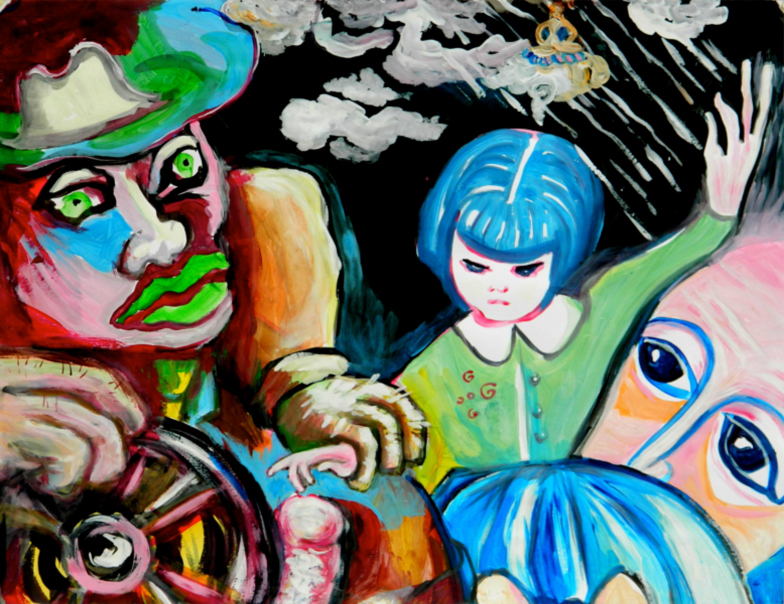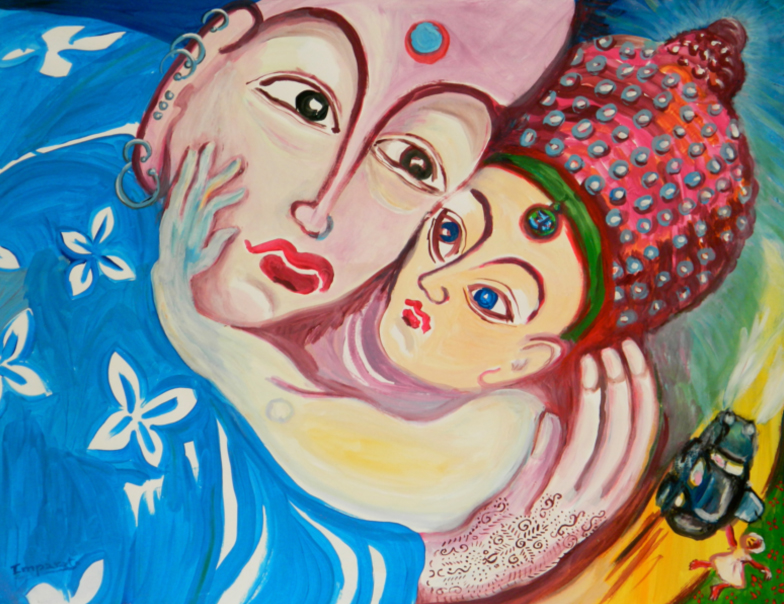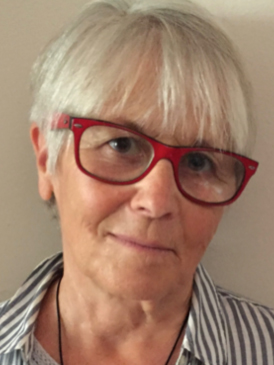“Through Darkness Into Light”
Issue #7, November 2018
TABLE OF CONTENTS
Deena Metzger, Lawrie Hartt, Karen Mutter, Eve Sanders, Andrea Mathieson, Lise Weil, Sharon Simone, Kristin Flyntz
Editorial
VILLAGE MEDICINE
Deena Metzger
Village
Sharon Simone
Fired Anew
Karen Mutter
Village Medicine
Lawrie Hartt
At the Stillpoint of Village Medicine
Eve Rachele Sanders
The View from the Ground
Andrea Mathieson
Listening to Bugs
Christine Holland Cummings
How to Go on When It Keeps Getting Darker
Noelle Imparato
Through Darkness Into Light
Kathy Miriam
Women, Water and Berta Caceras
AFTERMATH: 11/9
Praying Amid the Damage: Dreams, Nightmares, Visions
Kristin Flyntz
The Brown Tide
Sara Wright
Befriending the Dragon
Emilee Baum
The Demoness
Kathleen Kesson
After•Word Feverish World, 2018-2068
Lise Weil
After•Word Climate: A New Story and The Book of Joan
Noelle Imparato
THROUGH DARKNESS INTO LIGHT
 Plate 4: Calling for Mother, Noelle Imparato
Plate 4: Calling for Mother, Noelle Imparato
For fifteen years I recovered the milestones of my life through painting. I entered the studio, quieted my mind, and focused on the emotional layers buried in my body and rarely touched. With honesty and integrity, I allowed whatever image wanted to arise to arise. Spontaneous revelations came unhindered, almost magically, through the paint-brush when I let go of control—not the least a childhood trauma frozen in memory for fifty years.
I then spent five years deciphering the meaning of the paintings through writing. To my own amazement, they revealed a link between traumas and mystical experiences, transforming the wounds into a doorway to Spirit and facilitating genuine healing through transcendence. I was not expressing my life; my life was expressing itself through me.
*
I’m nine years old. The air is not particularly gloomy, just plain grey as Brittany can often be. I’m walking back home from school, my two little brothers playing ahead, when suddenly a big car stops by my side, black and shiny like our dad’s old Renault. The man at the wheel opens the passenger door and asks if I want a ride home. Without a second thought, I hiss myself onto the large cushy sit. As soon as the car starts rolling a creepy feeling runs through my guts. I take a sideways look at the man and discover a bulbous nose sticking out from underneath a felt hat, with pale lips below and piercing eyes above. He holds the wheel with one hand, shaggy with hair as thick as boar bristle, and he fusses in his trousers with the other. Before I know it he has unbuttoned himself and pulled out a piece of wrinkly flesh like I have never seen before. To my horror, he grabs my own hand and places it on top of this old flab. The touch feels disgustingly limp and scary, almost gooey like the fuzz of a poisonous caterpillar. Overtaken by revulsion and panic I wiggle as hard as I can to free myself from his grasp. Surprisingly he slows down and leans his big body over mine. I am livid. He opens the door and pushes me out while the car has hardly come to a stop. I fall into the ditch and blackout.
Unscathed, I come back to my senses and sit on the grass. The entire event has gone so fast I hardly know it has happened. Was it for real or was it a dream? I don’t really know what the man wanted from me but whatever it was it had to be “bad.” I contract in shame. This bad thing has happened to “me.” I instinctively sense that I would better keep this story to myself. Numbed from the shock, I get up and walk the last kilometer that separates me from home. All evening I remain in a daze, silent. No one notices. My mind toys with memory. It happened yet no one knows about it so it’s like it didn’t happen. I don’t even know if it did happen. It was a dream, and as a dream, it will go away. I didn’t speak. I couldn’t speak. What would I say anyway, and to whom? I couldn’t talk to my brothers, that much was certain. Mother? I couldn’t approach her, I feared her too much. She might even reprimand me. “Why didn’t you walk with your brothers as you were supposed to?” I was the guilty one. My sisters were all out of reach, either in boarding school or college. And if I did talk I feared that I would become the object of their ridicule for years to come. So I closed in and kept silent.
***
In my efforts to hold my secret locked in, my brain froze. The terrorizing experience vanished like a forgotten dream. It got erased. A paralyzing fear blocked my access to that information and an aspect of my memory function got lost in the process. Like frozen water, my mind congealed around this one traumatic object, preventing part of its synapses from flowing freely. My intellectual abilities remained intact but my long-term memory was debilitated. I could store data only for the short term. Learned lessons evaporated as soon as the test was over, planned schedules went to pieces, people’s names did not stick. Silence sealed the event. “Calling for Mother” painted fifty-three years later, re-opened the floodgate, opening up space for the healing process to take place.
By relating to a past event through the filter of later experiences, the creative act brings meaningful connections. Being wounded and dismantled opens the space for higher energies to move in and fill the space. Great traumas can open the door to great spiritual experiences. For instance, the portrayal of the pedophile evokes an evil character from a Hollywood gangster movie, though going to the movies or watching television didn’t happen for me until I was fourteen. My imagination gave form to a certain experience by using elements of a later one. Likewise with the small sculpture sitting on a cloud like a cartoon bubble above the child’s head; I recognize it as Tara, the Tibetan Tantric Great Mother figure of compassionate love, which became the guiding force of my life through an experience that happened a decade after my assault. Such are the workings of memory. We can only express the past from our present perception of reality. We create our new individual reality by reconstructing our past as social cultures create their new party line by reconstructing their past history.
In the giant pair of worried eyes behind the girl in “Calling for Mother,” I now see the frown on my mother’s forehead as an expression of the anxious concern for her children’s safety, which grew in her after she lost her third daughter from an accidental fall at the age of two. This revealed that when I was painting, I was aware of the loving bond between my mother and me, even if I consciously carried only anger toward her.
Then there is the girl raising her free hand toward the rainy skies in an explicit gesture of appeal to the Great Powers. In the Kabbalah tradition, clouds are seen as an aspect of the Upper Waters, which reciprocally communicate with the Lower Waters through the process of rain or involution, and evaporation or evolution. Water condenses in clouds and returns to earth in the form of life-giving rain. Rain is thus seen as water that comes from heaven. With one hand on the masculine organ and the other calling for the healing rain, the girl makes a plea to unite heaven and earth. Some transformative process is taking place.
***
Since I’ve started showing my paintings publicly, I’ve been surprised at how many women have come forward to share their own sexual abuses. On a minor register, our stories mirror war-rape victims’ inability to speak of their trauma, as in Rwanda. Typically those women feel stigmatized by an event that stamps a mark directly on their body, which they internalize as guilt. They are known to use metaphors as the only possible way of articulating their stories. I totally understand this avoidance of vocabulary?. In my case, only through painting was I able to melt the ice and create a release. Once the event was painted for all to see, then and only then, was I able to start speaking about it. And even at that, it took me several years before I could tell my story without collapsing.
Breaking the silence is essential. Bringing traumatic experiences to light and accepting them as an integral part of our being are two unavoidable steps in psychic recovery and social reintegration. Traumas can then be considered as the door-opener necessary to wholly accept ourselves. For women especially, but not only, this sharing of darkness is a way to fight isolation and the feeling of being ostracized, if not cursed, for the sexual assaults we suffered.
 Plate 5: EMBRACED BY THE MOTHER, Noelle Imparato
Plate 5: EMBRACED BY THE MOTHER, Noelle Imparato
“Embraced by the Mother” came with a sense of urgency immediately following “Calling for Mother.”
A Madonna and Child arose quickly on the white page, their distinctive Hindu features taking me completely by surprise. She looks like Shakti, the personification of the divine feminine creative power, or The Great Divine Mother; he evokes Krishna coiffed with a jeweled turban. The medallion on his forehead, which mirrors his mother’s third eye, is surprisingly adorned with a swastika, which in Hindu tradition is a tantric symbol of Shakti, meaning “being with higher self.”
These images perplexed me for a long time. At age nine I wasn’t acquainted yet with the Eastern culture, so why did they get here? And how do they relate to my sexual assault? Then I got it. The last detail painted at the last moment holds the key to the whole painting. In the lower corner is the little nine-year-old who has just been ejected from the black Renault, her body lying in the ditch. The relationship between the tiny car scene and the large mother figure seems to imply a bird’s eye view;. the girl had an out-of-body experience. We see her physical form from the vantage point of her spirit that has risen high above and found solace in the loving embrace of the Mother. After much reflection I finally recognize the same memorizing process at work in “Calling for Mother”: we “remember” or remember by recreating the past with elements of the future.
During the Christmas holidays of 1958, our first television set made its appearance at La Boulaye. I had just turned fourteen that day when the entire Plessis family squeezed into the living room to watch a documentary by Antonin Artaud on Mirra Richard, the spiritual consort of Sri Aurobindo, referred to as “La Mère” or “The Mother.” Considered by many to be the most representative Hindu writer of the 20th century, Sri Aurobindo was the first Indian to create a major literary corpus in English. As an “integral pioneer” he was deemed by the British colonial occupiers to be the “most dangerous revolutionary in India.” Yet his Ashram was located in the French colonial enclave of Pondicherry, thus “La Mère” was filmed in French, offering a rare opportunity in those days for French people to see an Indian yogi on television. Of course, I wasn’t aware of all this at the time, I was simply watching a woman whose beauty and energy mesmerized me. I could only perceive her glory as pertaining to religious icons, though she was not beautiful according to the canons of beauty in these images. No. She was old and wrinkled in that film, but through her radiant love, grace, and bliss she exuded such true nobility that for the first time in my life I felt embraced by a mother’s love.
Her teachings shook me at the core of my being. Their softness and strength pulled me into a mystery that I could only apprehend with my senses. It was a vast and spacious place unlike the certitudes of my Catholic upbringing. It wasn’t about original sin and the ten commandments, nor punishment and salvation for the chosen few, it was about a divine love incarnated in the body of “The Mother” as it could potentially be incarnated in each and every one of us. From high up on the television screen, she was looking straight at me, as if coming from an invisible world beyond. The purity of her being was touching my own. Her facial expressions were passing through me like the heartbeat of a mother to her child. I allowed a few silent tears to roll down freely. In plain daylight, I would’ve feared the sarcasm of my siblings, but in the intimacy of the dark I felt safe, and for one precious moment my heart opened to the infinite love of The Great Mother.
While “Calling for Mother” depicts the moment before the schoolgirl gets thrown out of the car, “Embraced by the Mother” is all about the moment after. In the first painting, the girl called up three versions of maternal love: her everyday mother, the Tibetan Buddhist Great Mother, and the Jewish Rain Waters. In the second, her plea has been answered. She is embraced by the divine mother. The activity of painting revealed a subconscious connection between the trauma I experienced at age nine and the bliss I was showered with at fourteen.
This explains the presence of Sri Aurobindo’s consort in the painting, but what about Krishna? He remained a puzzle to me until I learned that The Mother was known to have many times in her dreams encountered the infant Krishna, whom she later identified as Sri Aurobindo himself. This revelation raised the creative power of imagination to another level. The painting not only expressed my desire in the guise of an embrace by The Mother, but it also fused it with her own dream—unknown to me then—of encountering Sri Aurobindo in the form of Krishna. How deeply connected we are at the archetypal level!
I understand that this work of imagination is not an error. It harbors a strong healing power. It shows culture at work in the psychic realm of our ordinary lives. It alludes to the mythic nature of our perception of reality and to the fluidity of memory. Memory isn’t a fixed thing in a real past. Whether true, imagined, or false, those (transformed) memories bring the narrative into transformed and transforming images of our “self.”
By linking a life-threatening trauma to a spiritual awakening, “Embraced by the Mother” depicts a wound as a means of transcendence. By participating in the restoration of our wellbeing, our past acquires a new meaning. It transforms the vision of a trauma into a shock that awakens and sparks a sense of urgency for spiritual awakening.

Noelle Imparato was born in France where she was first trained as an architect at the Beaux Arts-Nantes, and as a filmmaker in Brussels, Belgium. In 1973, she moved to Los Angeles where she founded and headed “Airbrushé,” a graphic art studio that employed 75 people and created a million items of clothing airbrushed by hand in two years. She then worked as a film editor in Hollywood where she won two Eddies and an Emmy nomination. Her adaptation of Jane Roberts’ The Education of OverSoul 7 was acquired by Pierrot Prods. in 1986. Her documentary on teenagers in Hollywood, “Hollywood 90028,&rsdquo; aired on PBS-Los Angeles in 1997, and is now available in Public Libraries, notably at the Lincoln Center in New York, and on Youtube: https://www.youtube.com/watch?v=cRYLoMZHn5w&t=2308s
In 2002 she earned a Ph.D. in Mythological Studies with an emphasis in Depth Psychology at Pacifica Graduate Institute. At the same time she fell in love with process art painting. Over the next five years, she wrote a book about her transformational journey through art, “From Darkness Into Light: My Life in 40 Portraits” (not yet published). For the past twenty years, she has led her “Painting for LIFE” workshops in Los Angeles, France, Spain, and now Baltimore. Her paintings have been exhibited and sold in the US and abroad.
To comment on this article, please click here.
Copyright © 2014-2021 Dark Matter: Women Witnessing - All rights reserved to individual authors and artists.
Email: Editor@DarkMatterWomenWitnessing.com
Please report any problems with this site to webmaven@DarkMatterWomenWitnessing.com
